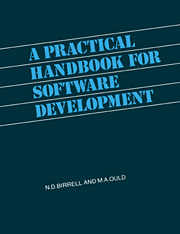Book contents
- Frontmatter
- Contents
- Foreword
- Preface
- 1 The choices facing the system developer
- 2 The software development process
- 3 Development techniques
- 4 Project Inception
- 5 System Definition
- 6 System Design
- 7 System Production
- 8 System Acceptance and Post-Acceptance Development
- 9 Project Debriefing
- Other bibliographies
- References
- Index
5 - System Definition
Published online by Cambridge University Press: 11 January 2010
- Frontmatter
- Contents
- Foreword
- Preface
- 1 The choices facing the system developer
- 2 The software development process
- 3 Development techniques
- 4 Project Inception
- 5 System Definition
- 6 System Design
- 7 System Production
- 8 System Acceptance and Post-Acceptance Development
- 9 Project Debriefing
- Other bibliographies
- References
- Index
Summary
The aims of the System Definition Phase
Once the decision has been made to proceed, this is the most important phase of development. Decisions made here influence the rest of the project. Time spent here is rarely less than well-spent, if properly directed. On the other side of the coin, this is one of the most difficult stages as regards knowing where you start, knowing when you have finished and knowing how to go about it.
The purpose is clear however, namely to decide the following:
What is to be produced,
When it is to be produced by,
What resources will be required to produce it.
These latter two may already have been determined for you. If so, you must regard them as constraints that limit what can be produced. In other words you will need to decide additionally that the system can actually be produced in the time with the resources.
Every project manager at this stage of his project needs to be reminded that there is a strong empirical correlation between failure to define a system adequately and failure to produce it. The temptation to short-circuit the Definition Phase is all the easier to succumb to, given the momentary feeling of an increased rate of progress.
The starting point of System Definition
It is most likely that you will start with some form of Requirement Specification.
- Type
- Chapter
- Information
- A Practical Handbook for Software Development , pp. 56 - 109Publisher: Cambridge University PressPrint publication year: 1985



